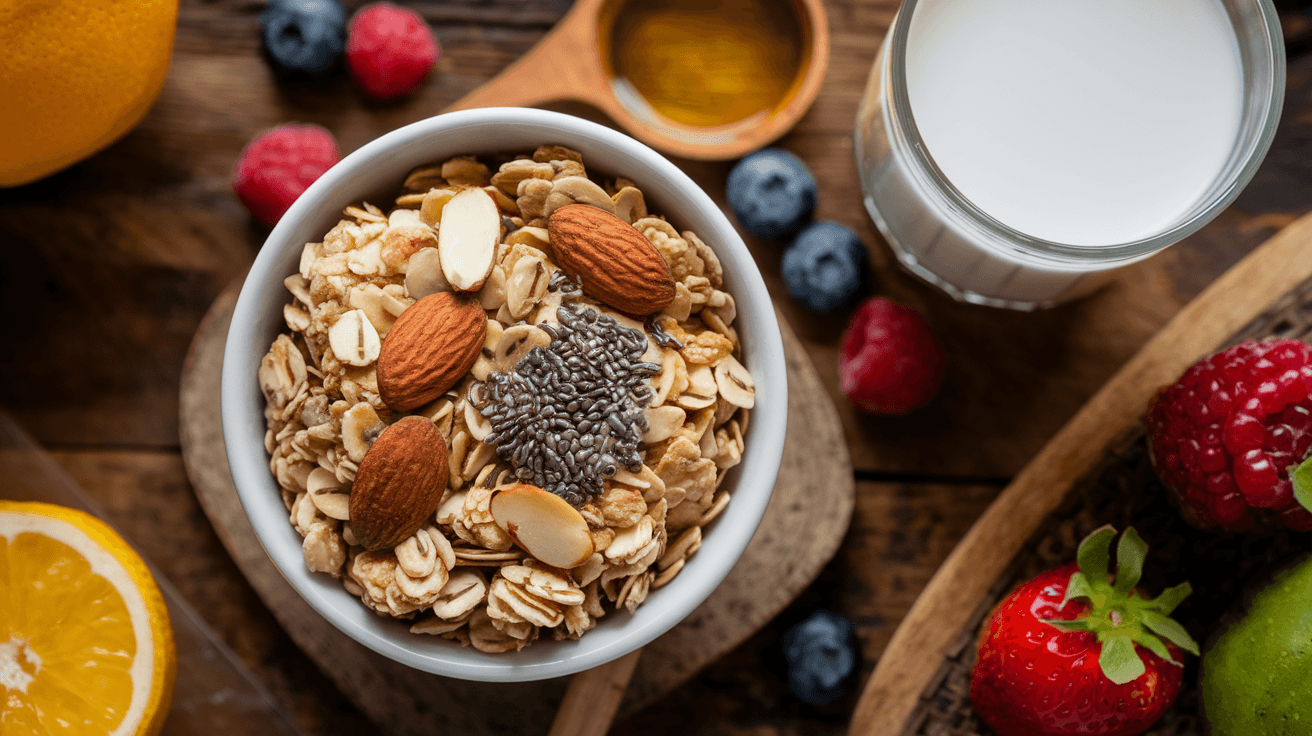Part 1: Understanding Granola
Introduction to Granola
What is granola made of? Granola is a mix of simple, healthy, and tasty ingredients like oats, nuts, and sweeteners. This versatile food has become a favorite worldwide, enjoyed as a quick breakfast, snack, or topping for yogurt and desserts.
The Origins of Granola: What Is Granola Made Of?
Granola was first created in the 1800s by Dr. James Caleb Jackson, who called it “Granula.” He made it using baked grains. Later, Dr. John Harvey Kellogg improved the recipe and renamed it “granola.” It started as a health food to help digestion, but over time, it became more about taste and convenience.
What Is Granola Made Of? Understanding Its Key Ingredients
Granola is a baked mix of oats, nuts, seeds, oils, and sweeteners. Unlike muesli, its close cousin, granola is toasted, giving it a crunchy texture and richer flavor.
Granola vs. Muesli: A Recipe Comparison
Here’s how granola is different from muesli:
- Granola is baked and crunchy.
- Muesli is raw and usually soaked in milk or yogurt before eating.
- Granola uses sweeteners like honey, while muesli often doesn’t.
Why Granola Is Popular in Healthy Diets
Granola is a top choice for people who care about health because it is:
- Full of fiber to aid digestion.
- Packed with protein for energy.
- Easy to customize to fit any diet.
What Is Granola Made Of? A Look at Core Ingredients
Granola is made from a mix of simple, natural ingredients. Let’s look at each part.
Oats: The Essential Ingredient in Every Granola Recipe
Oats are the main ingredient in granola. They are:
- High in fiber, which is great for digestion.
- Mild in flavor, so they mix well with other ingredients.
- Best used as rolled oats because they hold up during baking.
Nuts and Seeds: Why Are They in Granola Recipes?
Nuts and seeds make granola tasty and healthy. They add:
- Healthy fats to support heart health.
- Protein to keep you full longer.
- Crunch that makes eating granola satisfying.
Great options include:
- Almonds for vitamin E.
- Pumpkin seeds for zinc.
- Chia seeds for omega-3s.
Sweeteners in Granola: What Is Granola Made Of Recipe Highlights
Sweeteners help granola stick together and add flavor. Common choices include:
- Honey for a rich, natural sweetness.
- Maple syrup for a deep, earthy flavor.
- Stevia or agave as low-calorie alternatives.
For less sugar, you can use unsweetened fruit puree like mashed bananas.
Oils in Granola Recipes: Key Ingredients for Texture
Oil is important for a crispy texture. Popular choices are:
- Coconut oil, which adds a light sweetness.
- Olive oil, which gives a savory note.
- Avocado oil, which is mild and healthy.
Part 2: Customizing Your Granola
Customizing Your Granola
One of the greatest advantages of granola is its flexibility. With a few tweaks, you can transform a basic granola recipe into a personalized, nutrient-packed snack that suits your lifestyle and taste preferences.
Exploring Add-Ins for Flavor and Variety
Add-ins make granola unique, turning a standard recipe into something truly special. Here are a few options to consider.
Dried Fruits: Raisins, Cranberries, and More
Dried fruits add natural sweetness and a chewy contrast to the crunchy oats and nuts. Common choices include:
- Raisins: High in iron and antioxidants.
- Cranberries: A tart counterbalance to sweet ingredients.
- Apricots and mangoes: For a tropical twist.
Pro Tip: Chop larger fruits into bite-sized pieces to ensure even distribution.
Chocolate Chips and Coconut Flakes
For a touch of indulgence, incorporate:
- Dark chocolate chips: Packed with antioxidants.
- Coconut flakes: A great source of healthy fats and a subtle sweetness.
Add these after baking to prevent melting and burning.
Check out this low-sugar granola recipe for a healthier twist on your favorite breakfast or snack!
How to Choose the Right Ingredients
Selecting the best ingredients is key to crafting a granola that balances flavor and nutrition.
Balancing Nutritional Value and Taste
- Protein-packed nuts and seeds provide sustained energy.
- Low-glycemic sweeteners like maple syrup prevent sugar crashes.
- Whole-grain oats ensure a fiber-rich foundation.
Keep ingredient proportions in check to avoid overwhelming the recipe.
Low-Sugar Options for Health-Conscious Recipes
For those mindful of sugar intake, there are several options:
- Coconut sugar: A natural sweetener with a lower glycemic index.
- Monk fruit syrup: A calorie-free alternative.
- Unsweetened dried fruits: Natural sweetness without added sugars.
Check out this low-sugar granola recipe for a healthier twist on your favorite breakfast or snack!
Common Variations of Granola
Granola can easily adapt to various dietary restrictions and preferences, making it suitable for everyone.
Vegan Granola Options
To make your granola vegan, avoid animal-based sweeteners like honey. Instead, use:
- Maple syrup.
- Agave nectar.
- Coconut nectar.
Gluten-Free Granola Recipes
For a gluten-free granola, choose certified gluten-free oats. Many commercial oats are processed alongside wheat products, so double-check the label if you have celiac disease or gluten sensitivity.
Experimenting With Textures and Flavors
Customization doesn’t end with the ingredients. Play with textures and flavors by:
- Using a mix of finely chopped and whole nuts for variety.
- Adding spices like cinnamon, nutmeg, or cardamom for warmth.
- Incorporating vanilla or almond extracts for depth.
Part 3: Step-by-Step Granola Recipe
Creating your own granola is not only rewarding but also ensures you control the ingredients and flavors. Follow this simple recipe to craft a perfectly crunchy and customizable granola.
Detailed Guide: Preparing the Ingredients for Granola
Preparing your ingredients properly is the first step toward making perfectly crispy and flavorful granola. Here’s a comprehensive breakdown to ensure success:
Measuring the Dry Ingredients
Start by gathering the base dry ingredients that give granola its structure and crunch. These can be adjusted based on your preferences or dietary needs.
- 2 cups rolled oats
- Why it’s essential: Rolled oats provide the foundation of granola, offering texture and fiber. Their flat shape helps them bake evenly.
- Tip: Avoid instant oats, as they can become too soft during baking.
- 1 cup mixed nuts and seeds
- Options: Almonds, walnuts, sunflower seeds, pumpkin seeds, or pecans. These add healthy fats, protein, and a satisfying crunch.
- Preparation: Chop larger nuts like walnuts or almonds into smaller pieces to distribute them evenly throughout the granola.
- ½ cup shredded coconut (optional)
- Why use it: Adds a subtle sweetness and chewy texture, enhancing the overall granola mix. Choose unsweetened coconut if you want to control the sweetness.
- 1 teaspoon cinnamon
- Flavor boost: This warm spice brings out the sweetness of honey or maple syrup while adding an aromatic touch.
- A pinch of salt
- Flavor enhancer: A tiny amount of salt balances the sweetness and brings out the natural flavors of the nuts and oats.
Pro Tip: Prepping Your Nuts and Seeds
- Toast the nuts and seeds lightly in a dry skillet before adding them to the mixture for extra flavor.
- Keep an eye on them while toasting to prevent burning.
Choosing and Mixing Sweeteners and Oils
Sweeteners and oils are the binding agents that bring granola together and help it achieve a delicious, crispy texture.
Sweeteners:
- ¼ cup honey or maple syrup
- Function: These natural sweeteners help the granola stick together while caramelizing during baking.
- Custom options: For a less sweet version, reduce the amount or substitute with agave nectar, date syrup, or unsweetened applesauce.
Oils:
- 2 tablespoons coconut oil or olive oil
- Coconut oil: Adds a light, tropical flavor and crisps the granola.
- Olive oil: Provides a mild, savory flavor that pairs well with nuts.
- Alternative: Use avocado oil for a neutral, heart-healthy option.
Flavor Enhancer:
- 1 teaspoon vanilla extract
- Why it works: Vanilla deepens the sweetness of the honey or maple syrup and adds a comforting aroma.
Preparation Steps:
- In a medium bowl, combine your chosen sweetener (honey or maple syrup) with the oil and vanilla extract.
- Whisk thoroughly until the mixture is smooth and well blended.
- Taste the mixture and adjust for sweetness if needed.
Additional Tips for Success:
- If you prefer clumpy granola, use a bit more sweetener and press the mixture firmly onto the baking tray before placing it in the oven.
- Add spices like nutmeg, ginger, or cardamom to create unique flavor profiles.
By preparing the dry ingredients and sweetener-oil mix separately, you ensure that every oat, nut, and seed is evenly coated, resulting in perfectly baked granola with a rich flavor and satisfying crunch!
Check out this low-sugar granola recipe for a healthier twist on your favorite breakfast or snack!
Mixing and Baking the Granola
Once your ingredients are prepped, it’s time to mix and bake.
Achieving Even Coating of Ingredients
- Combine the dry ingredients in a large mixing bowl.
- Pour the sweetener and oil mixture over the dry ingredients.
- Mix thoroughly until every piece is coated. A silicone spatula works best for even distribution.
Setting the Oven Temperature and Baking Time
- Preheat your oven to 325°F (165°C).
- Spread the mixture evenly on a baking sheet lined with parchment paper.
- Bake for 20–25 minutes, stirring halfway through to ensure uniform toasting.
Pro Tip: Keep an eye on the granola during the last few minutes to avoid burning.
Storing and Serving Your Granola
Proper storage ensures your granola stays fresh and crunchy for weeks.
Proper Storage for Freshness
- Allow the granola to cool completely before storing.
- Transfer to an airtight container or mason jar.
- Store at room temperature for up to 2 weeks or freeze for longer shelf life.
Creative Serving Ideas: Breakfast Bowls, Snacks, and Toppings
Granola shines in both sweet and savory applications:
- Breakfast bowls: Layer with Greek yogurt, fresh berries, and a drizzle of honey.
- Snacks: Enjoy by the handful or mix with dried fruit for a homemade trail mix.
- Dessert toppings: Sprinkle over ice cream or baked apples for added crunch.
Check out this low-sugar granola recipe for a healthier twist on your favorite breakfast or snack!
FAQs: Granola
- What is the healthiest sweetener for granola?
Maple syrup or honey, as they’re natural and minimally processed. - Can I make granola without oil?
Yes, substitute oil with unsweetened applesauce for a lower-fat version. - How do I make granola clumpier?
Press the mixture firmly onto the baking sheet and avoid stirring during baking. - What’s the best way to make granola gluten-free?
Use certified gluten-free oats and check all additional ingredients for gluten contamination. - Can I freeze granola?
Absolutely! Store in an airtight container and freeze for up to 3 months. - What’s the difference between baked and raw granola?
Baked granola is toasted for crunch, while raw granola is simply mixed and consumed as-is. - Can I use steel-cut oats instead of rolled oats?
No, steel-cut oats won’t bake evenly and may result in a chewy texture. - How do I know when the granola is done?
The granola should be golden brown and fragrant. It will crisp up further as it cools. - Is granola good for weight loss?
Yes, in moderation. Opt for recipes with low sugar and healthy fats. - What can I substitute for nuts in granola?
Use seeds like sunflower or pumpkin seeds for a nut-free alternative.
Check out this low-sugar granola recipe for a healthier twist on your favorite breakfast or snack!

